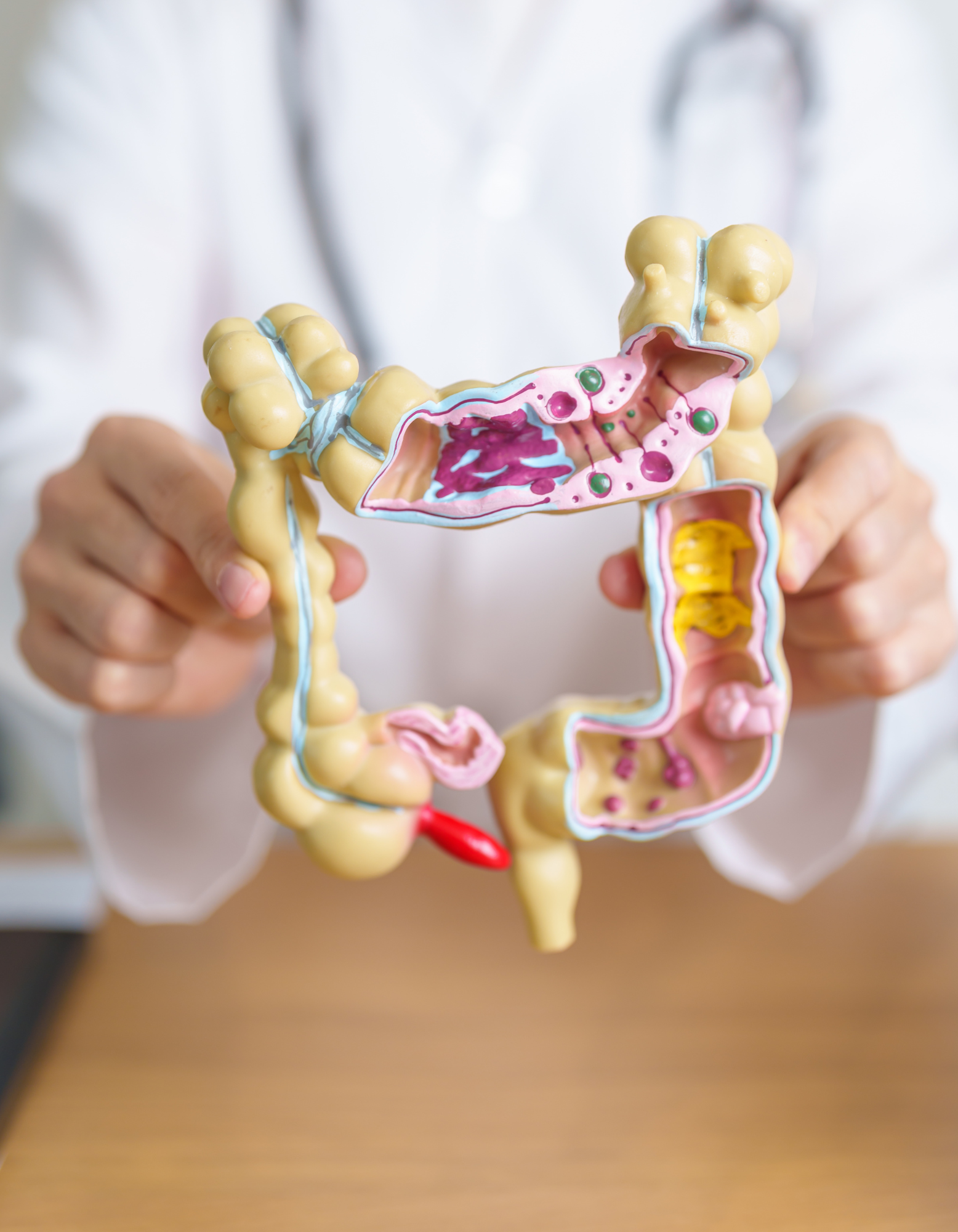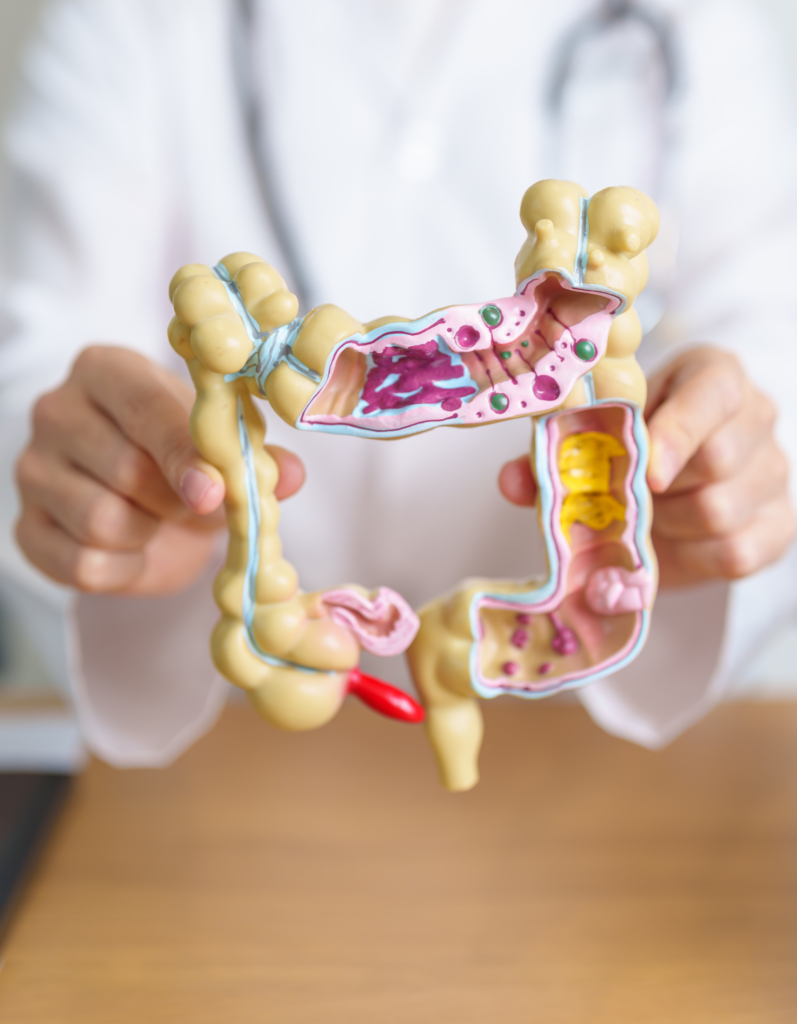Your cart is currently empty!

What is Colitis? A Comprehensive Guide to Understanding the Condition

Colitis is more than just a diagnosis—it’s a condition that can deeply impact daily life, from what you eat to how you feel, both physically and emotionally. If you or someone you love has been diagnosed with colitis, you may have questions, worries, and a desire to better understand what’s happening.
This guide is here to provide clarity. Whether you’re curious about the symptoms, exploring treatment options, or seeking tips for living with colitis, we’ve got you covered. We’ll break down the essentials of what colitis is, how it differs from conditions like Crohn’s disease, and what steps you can take to manage it effectively.
Living with colitis can feel overwhelming at times, but knowledge is power. With the right tools, strategies, and support, you can navigate this condition and focus on what matters most—your health and well-being. Let’s dive in and explore everything you need to know about colitis.
What is Colitis?
Colitis refers to inflammation of the colon, a vital part of your digestive system that helps process and eliminate waste. This inflammation can cause discomfort, disrupt daily life, and, in some cases, lead to serious complications. But what exactly is colitis, and why does it occur?
Colitis can result from several underlying causes, including infections, autoimmune responses, or reduced blood flow to the colon. It’s not a one-size-fits-all condition—there are various types of colitis, each with distinct causes and symptoms. For example, ulcerative colitis, a form of inflammatory bowel disease (IBD), is an autoimmune disorder where the body mistakenly attacks the colon’s lining. This results in chronic inflammation and sores, or ulcers, within the colon.
Other types of colitis include infectious colitis, caused by bacteria or viruses; ischemic colitis, which occurs when blood flow to the colon is restricted; and microscopic colitis, a less common form often linked to chronic diarrhea. Each type presents differently and may require unique treatments.
While colitis is a broad term, understanding its nuances is key to identifying and managing the condition effectively. Whether you’re dealing with mild symptoms or seeking answers about a more severe case, knowing what colitis is can help you take the first step toward better digestive health.
Ulcerative Colitis
Ulcerative colitis is a chronic form of inflammatory bowel disease (IBD) that specifically affects the inner lining of the colon and rectum. This condition causes persistent inflammation and sores, or ulcers, which can lead to a range of symptoms that significantly impact daily life. Unlike other types of colitis, ulcerative colitis is an autoimmune disorder, meaning the immune system mistakenly attacks the body’s own tissues.
What Are the Symptoms of Ulcerative Colitis?
Ulcerative colitis symptoms often vary depending on the severity of inflammation and the areas affected. Common symptoms include:
- Persistent diarrhea, sometimes accompanied by blood or mucus.
- Abdominal pain and cramping, often felt on the lower left side.
- Rectal bleeding or an urgent need to empty the bowels.
- Fatigue and unintended weight loss.
In severe cases, symptoms can escalate to fever, dehydration, or rapid heart rate, signaling the need for immediate medical attention. Symptoms may also fluctuate, with periods of intense flare-ups followed by times of remission when symptoms improve or disappear.
Why Early Diagnosis Matters
Ulcerative colitis is a lifelong condition, but early diagnosis can make a significant difference in managing symptoms and preventing complications. Left untreated, ulcerative colitis can lead to serious health issues, including colon damage, an increased risk of colon cancer, or life-threatening complications like toxic megacolon, where the colon becomes dangerously enlarged.
How Does Ulcerative Colitis Differ from Other Types of Colitis?
Unlike infectious or ischemic colitis, which often has short-term causes like infections or blood flow issues, ulcerative colitis is a chronic, autoimmune-driven condition. It’s also distinct from Crohn’s disease, which can affect any part of the digestive tract and penetrate deeper into the intestinal walls. Understanding these differences is crucial for getting the right diagnosis and treatment.
Living with ulcerative colitis can be challenging, but with the right medical care and lifestyle adjustments, many people find ways to effectively manage their symptoms and lead fulfilling lives. Recognizing the early signs and seeking professional advice is the first step toward better health and peace of mind.

Colitis vs. Crohn’s Disease
When it comes to inflammatory bowel diseases (IBD), colitis and Crohn’s disease are two of the most commonly discussed conditions. While they share some similarities, such as causing inflammation in the digestive tract, they are distinct in several important ways. Understanding the differences between colitis—particularly ulcerative colitis—and Crohn’s disease can help you navigate a diagnosis and pursue the right treatment plan.
Where Inflammation Occurs
One of the main differences lies in where the inflammation occurs:
- Ulcerative Colitis: This condition is limited to the colon (large intestine) and rectum, with inflammation only affecting the inner lining of the intestinal wall.
- Crohn’s Disease: Crohn’s can affect any part of the digestive tract, from the mouth to the anus. Unlike colitis, it often involves deeper layers of the intestinal wall, not just the surface.
Symptoms
While both conditions can cause abdominal pain, diarrhea, and fatigue, some symptoms are more specific to each:
- Colitis Symptoms: Bloody diarrhea and urgency to empty the bowels are hallmarks of ulcerative colitis due to its location in the colon and rectum.
- Crohn’s Symptoms: Symptoms may include abdominal pain, weight loss, and, in some cases, fistulas (abnormal connections between organs), which are rare in colitis.
Disease Patterns
The pattern of inflammation is another key distinction:
- Ulcerative Colitis: Inflammation is continuous, starting from the rectum and moving upward through the colon.
- Crohn’s Disease: Inflammation occurs in patches, meaning healthy sections of tissue can be found between inflamed areas, often called “skip lesions.”
Diagnosis and Tests
Both conditions require similar diagnostic tools, but specific findings can help differentiate between the two:
- Colonoscopy: This is the primary method for diagnosing ulcerative colitis, where continuous inflammation and ulcers in the colon lining are visible.
- Imaging: For Crohn’s, imaging techniques like MRI or CT scans may reveal inflammation in the small intestine or deeper layers of the digestive tract, which are not typically involved in colitis.
Complications
Both colitis and Crohn’s can lead to complications, but they often differ:
- Ulcerative Colitis: Increased risk of colon cancer, toxic megacolon, and severe bleeding.
- Crohn’s Disease: Fistulas, abscesses, and malnutrition due to its ability to affect nutrient absorption in the small intestine.
Why Knowing the Difference Matters
Accurately distinguishing between ulcerative colitis and Crohn’s disease is essential for effective treatment. While both conditions may involve anti-inflammatory medications and biologics, their specific locations and patterns of inflammation often require tailored approaches. If you’re experiencing symptoms, consult with a healthcare provider to determine the best path forward.
Symptoms of Colitis
The symptoms of colitis can vary widely depending on the type, severity, and underlying cause of the condition. For some, the signs may be mild and manageable, while others experience severe, life-disrupting symptoms. Understanding these symptoms is key to recognizing colitis early and seeking proper care.
Digestive Symptoms
- Diarrhea: One of the most common symptoms, diarrhea, can range from mild to severe and may include blood or mucus in the stool.
- Abdominal Pain and Cramping: Pain is often felt in the lower abdomen and can vary in intensity. Cramping is typically worse during flare-ups.
- Urgency to Empty Bowels: People with colitis often feel a sudden, urgent need to have a bowel movement, which can be accompanied by a sense of incomplete evacuation.
- Blood or Mucus in Stool: Inflammatory processes can cause bleeding in the colon or lead to excess mucus production, both of which are warning signs of colitis.
General Symptoms
- Fatigue: Chronic inflammation can drain your energy, leaving you feeling persistently tired even after rest.
- Weight Loss: Difficulty absorbing nutrients, combined with changes in appetite, can lead to unintended weight loss.
- Fever: A low-grade fever may occur during severe flare-ups or when an infection is present.
Extraintestinal Symptoms
Colitis doesn’t always stop at the digestive system. Many individuals experience symptoms that affect other parts of the body:
- Joint Pain or Swelling: Inflammation may extend to the joints, causing discomfort or arthritis-like symptoms.
- Eye Irritation: Conditions like uveitis or episcleritis can result in red, painful, or sensitive eyes.
- Skin Issues: Rashes or sores, particularly on the legs, can sometimes accompany colitis flare-ups.
Recognizing the Signs Early
Colitis symptoms can develop gradually or appear suddenly, depending on the type of colitis and its cause. For example:
- Ulcerative Colitis: Symptoms like bloody diarrhea and rectal bleeding are more common due to the specific location of inflammation.
- Infectious Colitis: Diarrhea, fever, and dehydration may appear suddenly after consuming contaminated food or water.
- Ischemic Colitis: This type often causes sudden, sharp abdominal pain and bloody stools due to reduced blood flow.
While these symptoms can overlap with other digestive conditions, such as Crohn’s disease or irritable bowel syndrome (IBS), persistent or severe signs should never be ignored. Early diagnosis and treatment are critical to managing colitis and preventing complications.

Causes and Risk Factors
Understanding the causes and risk factors of colitis is crucial for identifying potential triggers and taking steps to manage or prevent the condition. While the underlying causes of colitis vary depending on the type, the result is always inflammation of the colon, which can disrupt digestion and overall health.
Causes of Colitis
- Autoimmune Response
- Ulcerative Colitis: This type of colitis occurs when the immune system mistakenly attacks the lining of the colon, leading to chronic inflammation and ulcers. It is classified as an autoimmune condition and part of the family of inflammatory bowel diseases (IBD).
- Infections
- Infectious Colitis: Caused by bacteria, viruses, or parasites, this type of colitis can result from consuming contaminated food or water. Common culprits include Clostridium difficile, Salmonella, or E. coli.
- Reduced Blood Flow
- Ischemic Colitis: Occurs when blood flow to the colon is restricted, often due to blocked arteries, low blood pressure, or other circulatory problems.
- Irritation from Medications
- Certain medications, like nonsteroidal anti-inflammatory drugs (NSAIDs), antibiotics, or chemotherapy, can irritate the colon and trigger colitis symptoms.
- Radiation Therapy
- Radiation colitis can occur as a side effect of cancer treatment, especially in patients undergoing radiation for pelvic or abdominal cancers.
Risk Factors for Colitis
- Genetics
- Having a family history of colitis, especially ulcerative colitis or Crohn’s disease increases your risk. Certain genetic markers have been linked to an increased likelihood of developing these conditions.
- Age
- While colitis can develop at any age, ulcerative colitis is most commonly diagnosed in people between the ages of 15 and 30. Ischemic colitis, on the other hand, is more common in older adults.
- Lifestyle Factors
- Smoking: Smoking is a known risk factor for certain types of colitis, including Crohn’s disease and ulcerative colitis.
- Diet: Diets high in processed foods or low in fiber may contribute to inflammation and digestive discomfort, though they are not direct causes of colitis.
- Stress
- While stress doesn’t cause colitis, it can exacerbate symptoms and trigger flare-ups, especially in autoimmune types like ulcerative colitis.
- Geographic Location
- Colitis, particularly ulcerative colitis, is more common in Western countries, possibly due to environmental factors, diet, or hygiene practices.
Identifying the cause of colitis is essential for creating an effective treatment plan. For example, treating infectious colitis may involve antibiotics, while managing ulcerative colitis typically requires long-term medication and lifestyle changes. Understanding your risk factors can also help you take preventive steps, like quitting smoking, improving your diet, or seeking medical advice early if symptoms arise.
If you think you may be at risk for colitis or are experiencing symptoms, consult with a healthcare provider. Early diagnosis and management are key to improving outcomes and maintaining a better quality of life.
Diagnosis of Colitis
Diagnosing colitis can be a complex process, as its symptoms often overlap with other digestive conditions, such as Crohn’s disease or irritable bowel syndrome (IBS). However, identifying the type and cause of colitis is crucial for creating an effective treatment plan. Here’s what to expect during the diagnostic journey:
1. Medical History and Symptom Assessment
The first step in diagnosing colitis is a detailed discussion with your healthcare provider. They’ll ask about your symptoms, including:
- The frequency and severity of diarrhea or abdominal pain.
- Whether you’ve noticed blood or mucus in your stool.
- Any history of weight loss, fatigue, or fever.
They’ll also inquire about your lifestyle, diet, medications, travel history, and family history of inflammatory bowel disease (IBD) to identify possible triggers or risk factors.
2. Physical Examination
A physical exam often focuses on the abdomen to detect signs of tenderness, swelling, or other abnormalities. The provider may also look for signs of systemic inflammation, such as fever or joint swelling, which can accompany colitis.
3. Laboratory Tests
- Blood Tests: Bloodwork helps detect signs of inflammation, anemia, or infection. Markers like C-reactive protein (CRP) or erythrocyte sedimentation rate (ESR) can indicate inflammation in the body.
- Stool Tests: These tests identify infections (e.g., bacteria, viruses, or parasites) or markers of inflammation like calprotectin, which can distinguish inflammatory bowel disease from non-inflammatory conditions like IBS.
4. Diagnostic Procedures
To get a closer look at the colon, your doctor may recommend:
- Colonoscopy: This procedure involves inserting a thin, flexible tube with a camera into the colon to examine its lining. It allows the doctor to identify inflammation, ulcers, or other abnormalities and take tissue samples (biopsies) for analysis.
- Sigmoidoscopy: A similar procedure to a colonoscopy, but it only examines the lower part of the colon and rectum.
5. Imaging Studies
In some cases, imaging tests may be used to assess the extent of inflammation or rule out other conditions:
- CT or MRI Scans: These imaging tools can help visualize areas of inflammation, abscesses, or blockages in the digestive tract.
- X-rays: Rarely used, but sometimes helpful in diagnosing complications like toxic megacolon.
6. Differential Diagnosis
Colitis can resemble other digestive conditions, so your healthcare provider will work to rule out alternatives such as:
- Crohn’s Disease: If inflammation is patchy or extends beyond the colon.
- Infectious Colitis: If stool tests indicate bacterial or viral causes.
- Ischemic Colitis: If reduced blood flow to the colon is suspected, especially in older adults.
The type and cause of colitis determine your treatment options. For example, treating infectious colitis involves antibiotics, while managing ulcerative colitis may require long-term anti-inflammatory medications or biologics. A clear diagnosis also helps monitor your condition for potential complications, such as colon damage or an increased risk of colorectal cancer.
If you’re experiencing persistent symptoms, don’t delay seeking medical attention. Early and accurate diagnosis is the first step toward effective treatment and better quality of life.
Living with Colitis
Living with colitis can be challenging, but it’s entirely possible to lead a fulfilling and balanced life with the right tools, strategies, and support. Managing colitis means understanding your body, making informed choices, and creating habits that support both your physical and mental well-being.
Diet and Nutrition
Diet plays a significant role in managing colitis symptoms, particularly during flare-ups. While there’s no universal “colitis diet,” many people find relief by avoiding certain trigger foods and focusing on gentle, nutrient-dense options.
- During Flare-Ups: Stick to low-fiber, easily digestible foods like white rice, bananas, and boiled chicken to reduce irritation.
- In Remission: Incorporate a balanced diet with lean proteins, healthy fats, and cooked vegetables to support overall health and prevent nutrient deficiencies.
- Track Your Triggers: Keep a food diary to identify foods that exacerbate symptoms, such as dairy, caffeine, spicy foods, or alcohol.
Working with a registered dietitian familiar with colitis can help you craft a meal plan tailored to your needs.
Stress Management
While stress doesn’t cause colitis, it can worsen symptoms or trigger flare-ups. Incorporating stress-reducing practices into your daily routine can help:
- Mindfulness and Meditation: Techniques like deep breathing, yoga, or guided meditation can reduce anxiety and promote relaxation.
- Therapy: Cognitive-behavioral therapy (CBT) or support groups can provide tools to cope with the emotional toll of a chronic condition.
- Time for Joy: Engaging in hobbies, spending time with loved ones, or simply carving out moments of joy can have a significant impact on your mental health.
Physical Activity
Staying active can improve overall health, reduce inflammation, and boost mood. Choose low-impact activities that feel good for your body, such as:
- Walking
- Swimming
- Yoga or Pilates
Avoid overexertion during flare-ups, and listen to your body to determine what works best for you.
Building a Support Network
Living with colitis can sometimes feel isolating, but you’re not alone. Connecting with others who understand your experiences can make a world of difference:
- Family and Friends: Educate your loved ones about colitis so they can offer informed support.
- Support Groups: Join in-person or online groups through organizations like the Crohn’s & Colitis Foundation or platforms like Inspire.
- Healthcare Providers: Maintain an open and ongoing relationship with your doctor, dietitian, or counselor to address concerns as they arise.
Managing Daily Life with Colitis
Colitis doesn’t have to stop you from doing the things you love, but it might require some planning:
- Stay Prepared: Carry essentials like medication, snacks, or wet wipes for emergencies when you’re out and about.
- Communicate Your Needs: Don’t hesitate to discuss your condition with employers, teachers, or close friends when accommodations might be necessary.
- Pace Yourself: Rest when you need to, and remember that it’s okay to prioritize your health over obligations.
While living with colitis has its ups and downs, it’s important to focus on what you can control and celebrate small victories along the way. By staying informed, building supportive habits, and connecting with others, you can create a lifestyle that empowers you to live well with colitis. With the right care and mindset, a fulfilling and balanced life is within reach.

Treatment Options for Colitis
Treating colitis requires a tailored approach that addresses the underlying cause, manages symptoms, and prevents complications. Whether colitis stems from an autoimmune condition, infection, or reduced blood flow, treatment plans are designed to improve quality of life and support long-term health. Here’s a look at the most common treatment options available.
Medications
Medications are often the first line of defense for managing colitis. Depending on the type and severity of your condition, your doctor may recommend:
- Anti-inflammatory Drugs: Medications like mesalamine (5-ASAs) and corticosteroids help reduce inflammation in the colon, particularly for ulcerative colitis.
- Immunosuppressants: Drugs like azathioprine or cyclosporine can calm an overactive immune system in cases of autoimmune-driven colitis.
- Biologics: Advanced treatments like infliximab (Remicade) or adalimumab (Humira) target specific proteins that cause inflammation and are often used for moderate to severe cases.
- Antibiotics: Antibiotics can clear the infection and resolve symptoms of infectious colitis caused by bacteria.
- Antidiarrheal Medications: To provide relief from diarrhea, your doctor may suggest over-the-counter or prescription options, though these should only be used under medical supervision.
Dietary and Lifestyle Changes
Diet and lifestyle play a significant role in managing colitis symptoms. While these changes aren’t a substitute for medical treatment, they can greatly enhance its effectiveness:
- Dietary Adjustments:
- Avoid trigger foods like spicy dishes, dairy, or high-fiber items during flare-ups.
- Focus on low-residue foods that are easy on the digestive system, such as cooked vegetables, lean proteins, and refined grains.
- Stress Management: Practices like yoga, meditation, or mindfulness can help reduce stress, which is known to exacerbate colitis symptoms.
- Exercise: Low-impact physical activity can reduce inflammation and improve overall well-being.
Surgery
For some types of colitis, surgery may become necessary if symptoms are severe or if complications arise.
- Ulcerative Colitis: Surgical removal of the colon and rectum (proctocolectomy) is considered a cure for ulcerative colitis, though it often involves creating an ileostomy or a J-pouch.
- Other Types of Colitis: Surgery may be required to remove damaged sections of the colon, repair strictures, or address life-threatening conditions like toxic megacolon.
Complementary and Alternative Therapies
Some individuals find relief through complementary approaches, though these should always be discussed with your doctor:
- Probiotics: Support a healthy gut microbiome and may help with inflammation.
- Acupuncture: Some people report reduced pain and stress with this traditional practice.
- Herbal Supplements: Turmeric, aloe vera, and slippery elm are sometimes used, but their efficacy varies, and they may interact with medications.
Ongoing Monitoring and Preventative Care
Colitis is a chronic condition, and ongoing care is essential for effective management:
- Regular Check-Ups: Work closely with your healthcare provider to monitor your condition and adjust treatments as needed.
- Colon Cancer Screenings: People with long-term ulcerative colitis have an increased risk of colorectal cancer, so regular colonoscopies are critical for early detection.
No two cases of colitis are exactly alike, so it’s important to work with your healthcare team to develop a treatment plan that fits your unique needs. Whether it’s finding the right medication, making dietary adjustments, or exploring surgical options, managing colitis is a journey—but one that can lead to improved health and a better quality of life.
Research and Future Directions
The field of colitis research is constantly evolving, offering new hope for better treatments and a deeper understanding of this challenging condition. From advancements in medication to cutting-edge studies on the gut microbiome, the future holds promising possibilities for individuals living with colitis. Here’s a look at some key areas of ongoing research and what they could mean for the future of colitis management.
Advancements in Medications
One of the most significant areas of progress is the development of new medications to better target inflammation and reduce side effects.
- Next-Generation Biologics: Researchers are refining biologic therapies to make them more effective for specific subtypes of colitis. New options aim to provide longer-lasting relief with fewer injections or infusions.
- Small Molecule Drugs: Oral therapies like Janus kinase (JAK) inhibitors and sphingosine-1-phosphate (S1P) modulators are emerging as alternatives to injectable biologics, offering convenience and targeted relief.
Personalized Medicine
The future of colitis treatment lies in personalized medicine, where therapies are tailored to an individual’s genetic makeup, microbiome composition, and disease characteristics. This approach could help identify the most effective treatments faster, minimizing the trial-and-error process that many patients currently face.
Gut Microbiome Research
The gut microbiome—the trillions of bacteria, viruses, and fungi living in your digestive tract—plays a crucial role in inflammatory bowel diseases like colitis.
- Fecal Microbiota Transplants (FMT): Transferring healthy gut bacteria from a donor to a patient has shown promise in treating certain types of colitis, particularly those triggered by infections like Clostridium difficile.
- Probiotic Therapies: Researchers are investigating specific strains of probiotics that could reduce inflammation and restore balance to the gut microbiome.
Stem Cell Therapy
Stem cell therapy is a cutting-edge area of research with the potential to revolutionize colitis treatment. This approach involves using stem cells to repair damaged tissues and modulate the immune system, potentially providing long-term remission for patients with severe colitis.
Dietary Studies
Scientists are exploring the impact of diet on colitis, including:
- Elimination Diets: Identifying trigger foods and creating tailored meal plans to minimize symptoms.
- Exclusive Enteral Nutrition (EEN): Liquid diets used as a primary therapy for inflammation in certain cases.
- Anti-Inflammatory Diets: Diets designed to reduce overall inflammation in the body, such as the Mediterranean diet, are being studied for their impact on colitis.
Clinical Trials
Ongoing clinical trials are critical to testing new therapies and improving existing ones. Participating in a clinical trial not only gives patients access to innovative treatments but also contributes to the broader understanding of colitis. You can explore trials through resources like ClinicalTrials.gov or organizations like the Crohn’s & Colitis Foundation.
Thanks to advancements in research, the outlook for people living with colitis is becoming increasingly hopeful. While a cure remains elusive, the development of more effective treatments, personalized approaches, and a better understanding of the gut microbiome offers new possibilities for managing the condition. Staying informed about these advancements can help you take an active role in your care and explore options that improve your quality of life.
Resources for Support
Living with colitis can feel overwhelming, but you don’t have to face it alone. Whether you’re newly diagnosed, managing ongoing symptoms, or supporting a loved one, there are plenty of resources available to help you navigate this journey. From expert advice to community support, these tools can make a world of difference.
Trusted Organizations
These organizations provide reliable information, support services, and updates on the latest research:
- Crohn’s & Colitis Foundation: Offers educational resources, local support groups, and access to clinical trials.
Website: crohnscolitisfoundation.org - National Institute of Diabetes and Digestive and Kidney Diseases (NIDDK): A government resource offering comprehensive information about colitis and related conditions.
Website: niddk.nih.gov - American Gastroenterological Association (AGA): Focuses on digestive health and provides resources for patients managing colitis.
Website: gastro.org
Online Communities and Support Groups
Connecting with others who understand your experiences can provide encouragement and practical advice:
- Inspire IBD Support Group: A safe space to share your story, ask questions, and learn from others living with colitis.
Website: inspire.com - MyCrohnsAndColitisTeam: A social network specifically for people with Crohn’s and colitis, offering tips, emotional support, and a sense of community.
Website: mycrohnsandcolitisteam.com
Apps and Tools for Management
- GI Buddy: An app developed by the Crohn’s & Colitis Foundation to help track symptoms, medications, and triggers.
- Flaredown: Designed for chronic illness management, this app helps you log daily experiences to identify patterns over time.
Books and Educational Materials
For those who want a deeper understanding of colitis, these books are great resources:
- “Crohn’s and Colitis For Dummies” by Tauseef Ali, MD: A beginner-friendly guide with practical tips for managing IBD.
- “The First Year: Crohn’s Disease and Ulcerative Colitis” by Jill Sklar: A step-by-step guide to navigating the first year after diagnosis.
Advocacy and Awareness
Participating in advocacy efforts can help raise awareness and support ongoing research:
- IBD Awareness Month (May): Join events and campaigns to bring attention to colitis and other IBD conditions.
- Local Support Groups: Many communities have in-person support groups organized through hospitals or organizations like the Crohn’s & Colitis Foundation.
Living with colitis comes with its challenges, but there are countless resources and communities ready to offer guidance, support, and understanding. Whether you’re seeking medical advice, emotional encouragement, or practical tips, help is always within reach. By staying connected and informed, you can take charge of your health and thrive despite the obstacles.
Living with colitis may come with its challenges, but it’s also a journey of resilience and self-care. Understanding the condition, recognizing symptoms early, and staying proactive with treatments and lifestyle adjustments can help you manage colitis and reclaim control over your life. With the right support, both from your healthcare team and your community, it’s possible to live a fulfilling and balanced life.
Whether you’re navigating a recent diagnosis, supporting a loved one, or seeking ways to improve your quality of life, know that you’re not alone. There are countless resources, tools, and communities ready to guide you every step of the way. By educating yourself and reaching out for help, you’re taking an important step toward better health and well-being.
If you found this guide helpful, don’t miss out on more expert insights and tips. Sign up for our newsletter to stay informed about the latest research, practical advice, and resources for living well with colitis. Together, we can take the journey toward better health—one step at a time.

Leave a Reply